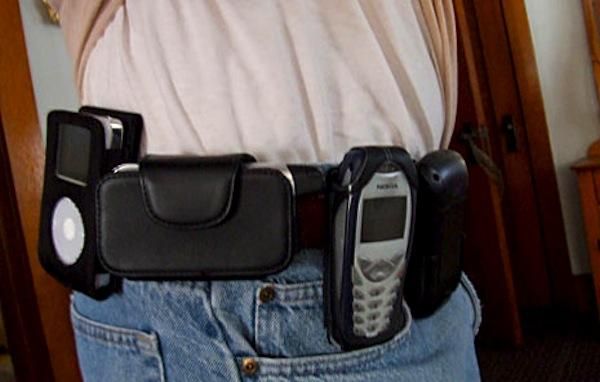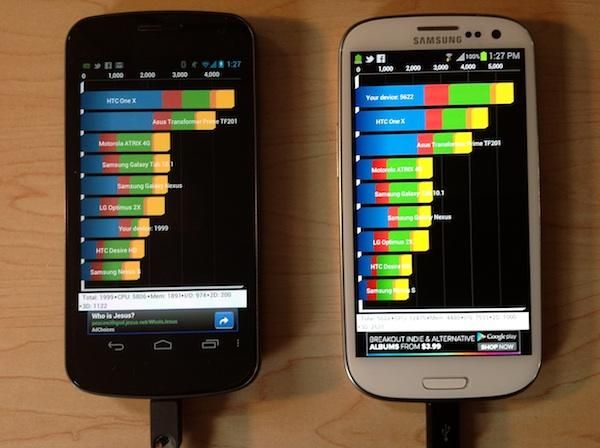A little while back, I posed the question of what makes a smartphone "too thin." There's no question that the race is still on when it comes to measurable physical specs, with OEMs biting and snapping at one another, engaging in petty wars of engineering in order to claim the title of "thinnest" or "biggest" or "fastest." Everyone wants to claim they're the "best" at something, especially corporations which stand to make a fair bit of money with such ostentatious proclamations.
So much of the mobile communications world is subjective, though; "best" is in the eye of the beholder when it comes to platforms, skins, sound quality, display coloring, casing design ... the list goes on forever. So an OEM trying to distinguish itself from the pack can be helped enormously by specs: objective (most of the time) measuring sticks, unassailable metrics that loudly, clearly, unqualifiedly declare just who the "real" winner is.
It's easier with factors like size and shape; there are an endless number of tricks manufacturers can use to increase the perceived thick- or thin-ness of a device. Beveling, bezel-trimming, strategically placed bulges ... it's all part of the toolbox of trickery.
Know what's not as easy to fudge? Weight.
... unless you have a Vomit Comet handy.
Mobile phones are inherently portable devices. As they've have grown in popularity, becoming ubiquitous throughout much of the developed world, the pressures on their physical parameters have also grown. No one wants to carry an oversized brick in his or her pocket (though there's a recent trend in that direction), and no one wants to be weighed down by that same brick. The pressure to stay slim and trim in the smartphone world is just as intense as it is on the beaches of the real world. Maybe more intense.
In the portable-electronics world, low weight is a good thing. Avoiding extra ounces has taken us from cassette-based Walkmans to ever-slimmer portable Discmen to MP3 players, with a brief stop at MiniDisc players stuck in there for a handful of us. In concert with the drive toward smaller footprints, it's allowed us to graduate from phones that required their own bag, to devices like the Xperia Mini and HP Veer, devices so small they get lost in a pocket. And that's awesome; eliminating the need for phone-bearing belt clips was one of humanity's greatest fashion victories.
Now we just have to do away with cases and we'll be set.
But, as in all things, there's a tradeoff to being too tiny.
One of my biggest focal points, when evaluating a new mobile phone, is the device's "feel in hand." That includes a few different factors, like casing material, shape, and size, but a huge component is the device's weight.
Take the Samsung Galaxy S III sitting next to me. There's a lot I like about it, but almost none of that is physical; the plastic feels cheap and the detailing looks cheesy to my eye, but what really irks me is the weight. In my video comparison between it and the Galaxy Nexus, I call the Galaxy S III "chintzy" compared to its older cousin. A big part of that, for me, is its lack of heft. At 133g, the Galaxy S III is immensely pocketable and doesn't weigh me down at all, but compared to the 150g of my LTE Galaxy Nexus, it feels somehow inferior. In fact, putting the devices side-by-side made me realize how much more slack I'm willing to give the Galaxy Nexus' somewhat vanilla design. That's in large part due to the latter's added weight.
Get ya'self to the Butterfly Lounge, find ya'self a big smaaaart-phooooone.
Maybe it's a cultural thing, this correlation between weight and perceived quality, but it's definitely not a new concept. Alastair S. MacDonald discussed the nature and impact of "aesthetic intelligence" in a paper for the Journal of Engineering Design back in 2001, specifically calling out weight as one of the factors we emphasize when evaluating a product's value:
Consider the following scenario. On approaching a car, your initial impressions of the object, formed visually, may be attraction, indifference or dislike. Next you open the door. You judge the weight and quality by feel and sound: does the door hinge feel secure, and does the door catch make the right sound as it closes?
A similar process happens with every phone I unbox: the box materials give me a sense of what I can expect, and the way the phone is presented within gives me further cues. It's not until I pick it up, though, forming that tactile bond for the first time, that my overall impressions of the device start to form. Even then, these impressions are malformed and skewed, as the device's battery is almost never preinstalled. Not until minutes later, when the phone is assembled and flickering to life for the first time, do I get a sense of how cheap or luxurious it is, based on its feel in my hand.
Other parts of the world don't draw the same association between weight and quality, but it doesn't seem to be hurting sales on either side of the spectrum: Apple is having no trouble moving the 140g iPhone 4S globally, and on the flip side, Micromax has debuted quite a stunning device in the Modu T, weighing only 55g. While it's not technically a smartphone, Micromax is billing it as the "world's lightest 3G phone" and the "world's lightest touch phone."
Perfect for a shirt pocket ... and probably not much else.
As with so many aspects of mobile phones, the question of "how light is too light" ultimately comes down to personal preference. For me, someone who places a high value on quality of workmanship and well-engineered hardware, weight is of crucial importance, with heavier equaling better (up to a point). For someone who places more importance on extreme portability, or someone who doesn't want to feel weighed down by his or her smartphone, that perspective will obviously be different. And like screen size and thickness metrics, the goalposts for the perfect "sweet spot" in device weight will continue shifting over time.
Which do you prefer: rail-thin phones, or those with a little meat on their bones? Let us know in the comments! And while you're at it, tell us what mobile phone of yours had the best weight/size combination.
Aesthetic Intelligence paper source: Journal of Engineering Design, via Taylor & Francis Online
Modu-T information source: Micromax





